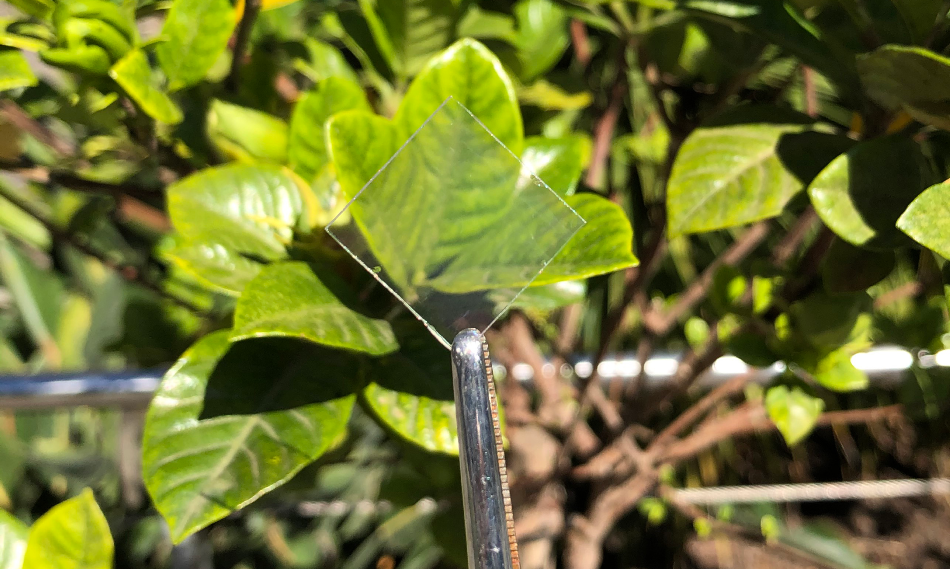Aug 6 2020
The cost of heat-repelling glass and energy-saving smart windows could be considerably reduced by a simple technique to form clear coatings that can block heat and conduct electricity.
 The ultra-thin clear coatings are made with a new spray-on method that is fast, cost-effective and scalable. Image Credit: RMIT University.
The ultra-thin clear coatings are made with a new spray-on method that is fast, cost-effective and scalable. Image Credit: RMIT University.
At the RMIT University, scientists have designed spray-on coatings that are ultra-thin, economical, and surpass the performance of existing industry standards for transparent electrodes.
Integrating the best properties of metals and glass in a single component, a transparent electrode is a highly conductive clear coating that permits the passage of visible light.
Coatings are the essential components of technologies such as solar panels, LED lighting, touchscreen displays, and smart windows. At present, these are manufactured through time-intensive processes that are based on high-cost raw materials.
The new spray-on technique is scalable, fast, and relies on cost-effective materials that are readily available.
The technique could enable simple fabrication of smart windows, which are both dimmable and energy-saving, as well as low-emissivity glass, where a traditional glass panel is coated with a unique layer to reduce the passage of infrared and ultraviolet light.
According to the lead investigator of the study Dr Enrico Della Gaspera, the innovative method could be employed to significantly reduce the cost of energy-saving windows and possibly enable their regular use in retrofits and new buildings.
Smart windows and low-E glass can help regulate temperatures inside a building, delivering major environmental benefits and financial savings, but they remain expensive and challenging to manufacture.
Della Gaspera, Senior Lecturer and Australian Research Council DECRA Fellow, RMIT University
Gaspera added, “We’re keen to collaborate with industry to further develop this innovative type of coating. The ultimate aim is to make smart windows much more widely accessible, cutting energy costs and reducing the carbon footprint of new and retrofitted buildings.”
The new technique can also be accurately tuned to produce coatings customized to the conductivity and transparency needs of several different applications of transparent electrodes.
Global demand for smart glazing
By 2022, the global market size for smart windows and smart glass is anticipated to reach $6.9 billion, whereas the global low-E glass market is set to achieve an estimated $39.4 billion by 2024.
New York’s Empire State Building announced energy savings of $US2.4 million and reduced carbon emissions by 4000 metric tons following the installation of smart glass windows.
Melbourne’s Eureka Tower features a higher use of smart glass in its “Edge” tourist attraction, a glass cube that projects 3 m out of the building, where visitors are suspended from 300 m above the city.
The glass turns opaque when the cube pops out over the edge of the building and turns clear once extended completely.
According to first author Jaewon Kim, a PhD researcher in Applied Chemistry at RMIT, the next steps in the study were to create precursors with the ability to degrade at lower temperatures. This will enable the coatings to be deposited on plastics and utilized in flexible electronics, as well as to make huge prototypes by scaling up the deposition.
The spray coater we use can be automatically controlled and programmed, so fabricating bigger proof-of-concept panels will be relatively simple.
Jaewon Kim, Study First Author and PhD researcher, Applied Chemistry, RMIT University
The study was financially supported through funding from the Australian Research Council, with key imaging and analysis performed at RMIT’s Microscopy and Microanalysis Facility (RMMF).
The study was facilitated in part by using the Central Analytical Research Facility (CARF) at the QUT Institute for Future Environments.
Journal Reference
Kim, J., et al. (2020) Ultrasonic Spray Pyrolysis of Antimony-Doped Tin Oxide Transparent Conductive Coatings. Advanced Materials Interfaces. doi.org/10.1002/admi.202000655.